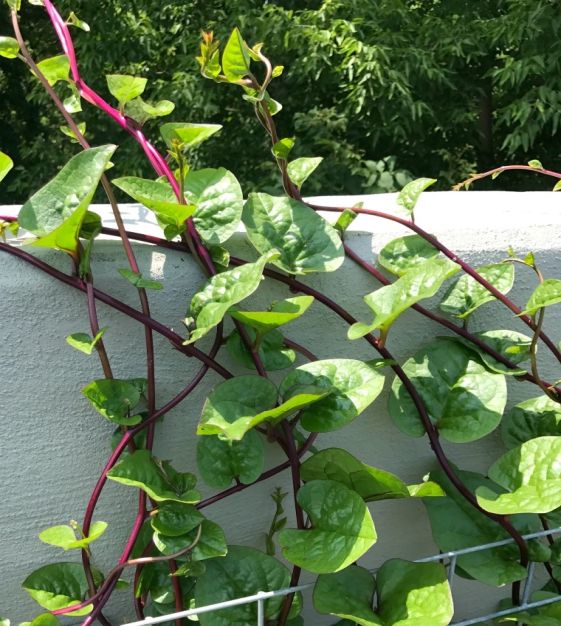Back to Top
Malabar Spinach
55 days. A fabulous heat-loving vine from the tropics, Malabar Spinach stands up to 90°F-plus heat without wilting and perishing like most other greens. Its leaves may be used as a fresh baby leaf in salads or cooked like regular Spinach in stir-fries, creamed concoctions and soups. AKA Creeping Spinach, Malabar Spinach is as versatile as it is strange. High in vitamins A and C, iron, calcium and protein per calorie, this Basella is a good source of soluble fiber and an effective thickening agent for Asian soups and curries. In cool weather, its growth slows to a crawl, but in hot weather it sprints along supportive structures at an amazing clip. Normally raised as an annual, it may perennialize in frost free areas. Plant it in the warmest spot possible with full sunlight, rich, well-draining soil and a supportive structure on which to train its prolific vines. It should be evenly watered to inhibit bolting and to keep its thick, red-stemmed, verdant-green leaves from becoming bitter. (Its foliage and form is almost as beautiful as a Climbing Hydrangea if you want to create mixed ornamental/edible beds.)
One packet of about 100 seeds
One packet of about 100 seeds
- Buy 10 for $5.10 each and save 10%
- Buy 50 for $4.25 each and save 25%
- Information
- Gardening Tips
Spinach prefers the cool, sunny weather of late spring and early fall. Direct-sow Spinach in the spring once the threat of frost has passed, and in late summer for fall harvest. Spinach adores rich soil: amend the Spinach bed well with compost and/or manure, dolomite lime and complete organic fertilizer. Keep the bed evenly moist and weeded. Early thinnings are wonderful for spring salads. For the kitchen gardener, it is practical to harvest by using the outer leaves from each plant or by cutting the whole plant, leaving 1" for possible regrowth. Or, broadcast seed and grow as a cut-and-come-again crop of tender leaves. If you simply must have Spinach during summer's dog days, plant the seed deeper, provide partial shade and water copiously. Convert everyone you know into Spinach-lovers with Carole Peck's Baked Penne Pasta with Lobster and Spinach and The Culinary Institute of America at Greystone's Spinach and Caramelized Onion Soufflé.
Average seed life: 2 years.
Average seed life: 2 years.
Spinach prefers the cool, sunny weather of late spring and early fall. Direct-sow Spinach in the spring once the threat of frost has passed, and in late summer for fall harvest. Spinach adores rich soil: amend the Spinach bed well with compost and/or manure, dolomite lime and complete organic fertilizer. Keep the bed evenly moist and weeded. Early thinnings are wonderful for spring salads. For the kitchen gardener, it is practical to harvest by using the outer leaves from each plant or by cutting the whole plant, leaving 1" for possible regrowth. Or, broadcast seed and grow as a cut-and-come-again crop of tender leaves. If you simply must have Spinach during summer's dog days, plant the seed deeper, provide partial shade and water copiously. Convert everyone you know into Spinach-lovers with Carole Peck's Baked Penne Pasta with Lobster and Spinach and The Culinary Institute of America at Greystone's Spinach and Caramelized Onion Soufflé.
Average seed life: 2 years.
Average seed life: 2 years.




